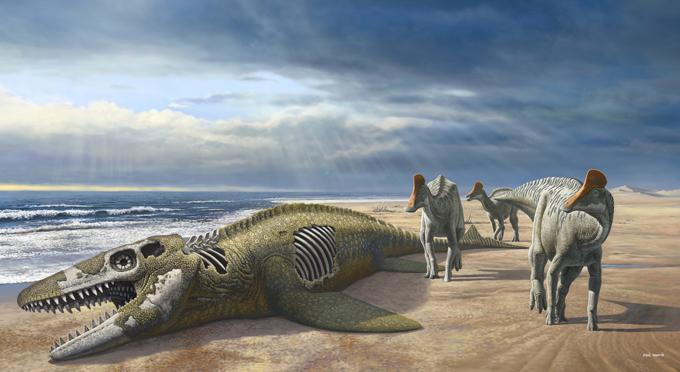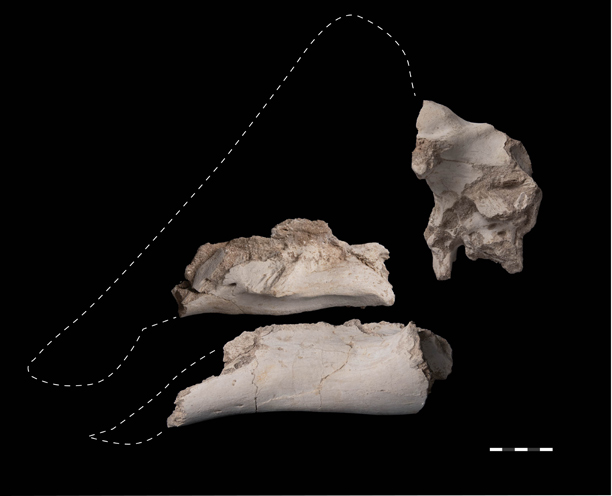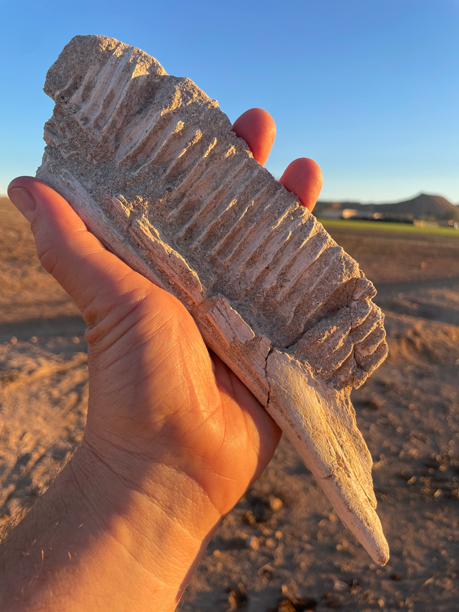A new, pony-sized Moroccan lambeosaurine dinosaur has been named and described. The new dinosaur has been named Minqaria bata. It closely resembles the only previously known African duckbill, Ajnabia odysseus. However, the shape of the jaws and teeth are unique, demonstrating it was a distinct species. Minqaria probably occupied a different ecological niche.

Minqaria bata – (Arabic for “Beak” and “Duck” Respectively)
The fossils consisting of a right maxilla with teeth, a partial left dentary and the braincase come from marine phosphate deposits located at Sidi Chennane in the Oulad Abdoun Basin. The size of the fossils, the associated matrix and the lack of duplication of elements suggests that these fossils came from a single, mature dinosaur. They represent a dwarf duck-billed dinosaur, a Late Cretaceous lambeosaurine that was smaller than Ajnabia odysseus, the first hadrosaurid known from Africa (Longrich et al, 2020). M. bata is estimated to have been around 3.5 metres in length and weighed approximately 250 kilograms.
To read Everything Dinosaur’s 2020 blog post about Ajnabia odysseus: The First Hadrosaurid Dinosaur from Africa.
The genus name is derived from the Arabic “minqar” which means beak and the species name is from the Arabic “bata” for duck.

The Diversity of North African Lambeosaurines
A humerus and femur also described in the scientific paper appear to represent lambeosaurines too. However, their size indicates that larger lambeosaurines, animals longer than six metres in length were also present in the ecosystem.
The discovery of Ajnabia in 2020 was surprising. During the Late Cretaceous, hundreds of miles of water separated North Africa from Eurasia. The new lambeosaurine fossils not only confirm the existence of lambeosaurines in North Africa, but shows they were diverse, with at least four taxa present.
How Did Duck-billed Dinosaurs Get to North Africa?
This new study published in the journal “Scientific Reports” reveals that not only did duckbills manage to cross the Tethys Sea, but they became highly diverse once they colonised Africa. The duck-billed dinosaurs are thought to have evolved in North America. Africa during the Late Cretaceous was an isolated continent, surrounded on all sides by water. So, how did duckbill dinosaurs, a group that evolved in North America, end up in Morocco?
Anatomical traits of Minqaria are similar to European hadrosaurs. The researchers postulate that duckbills either swam or floated across several hundred kilometres of open water to colonise Africa.
Dr Nick Longrich (University of Bath), who led the study commented:
“These were probably loud, vocal animals. Modern birds vocalise to find mates, or to declare territories. But they’re especially vocal in flocks – a flock of flamingos or a nesting colony of pelicans is extremely noisy, constantly communicating. So, it’s likely that like birds, these duckbills were social animals.”
Social Dinosaurs
The brain is also large by dinosaur standards, a feature associated with social animals like crows and primates.
Dr Longrich explained:
“There were probably very loud, noisy herds – or flocks if you prefer – of these little duckbills wandering the coasts of Morocco 66 million years ago.”

Commenting on the presence of lambeosaurine dinosaurs on the isolated continent of Africa, Dr Longrich added:
“Not only did duckbills manage to reach Africa at the end of the Cretaceous, but once they did, they quickly evolved to take advantage of open niches and became diverse.”
Analogies can be found in the modern world. Animals can sometimes make unexpected and unusual journeys across large bodies of water. During the Ice Age, elephants, deer and hippos were able to cross the Mediterranean Sea to reach the island of Crete. Iguanas swept offshore by a hurricane can be transported hundreds of miles to other Caribbean islands as they cling to dislodged vegetation.
Dr Longrich stated:
“It’s extremely improbable that dinosaurs could cross water to get to Africa, but improbable isn’t the same as impossible. And given enough time, improbable things become probable. Buy a lottery ticket every day, and if you wait long enough, you’ll win. These ocean crossings might be once-in-a-million-year events but the Cretaceous lasted nearly 100 million years. A lot of strange things will happen in that time – including dinosaurs crossing seas.”
Remarkable to Discover Fossils of Hadrosaurs Like Minqaria bata in Africa
Co-author Dr Nour-Eddine Jalil (Natural History Museum of Paris and the Université Cadi Ayyad in Morocco) commented:
“Minqaria and its relatives are players that a few years ago we would never have supposed to be on the African continent at that time.”
The doctor added:
“The phosphates of Morocco offers new images on past biodiversity in a key period of the history of life, the last moments of the dinosaur age followed by the diversification of mammals, announcing a new era. Despite their marine origin, these phosphates of Morocco also contain remains of vertebrates that lived on land. They constitute one of the only windows on the terrestrial ecosystems in Africa. The dinosaur remains suggest a great diversity, all the three major groups of dinosaurs are represented, the abelisaurid carnivores and the sauropod and ornithischian herbivores.”
Everything Dinosaur acknowledges the assistance of a media release from the University of Bath in the compilation of this article.
The scientific paper: “A new small duckbilled dinosaur (Hadrosauridae: Lambeosaurinae) from Morocco and dinosaur diversity in the late Maastrichtian of North Africa” by Nicholas R. Longrich, Xabier Pereda-Suberbiola, Nathalie Bardet and Nour-Eddine Jalil published in Scientific Reports.
The Everything Dinosaur website: Everything Dinosaur.








Leave A Comment